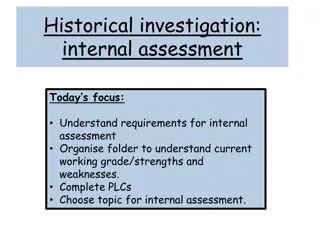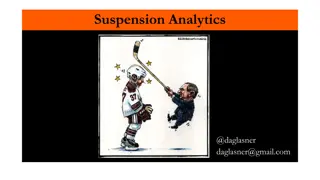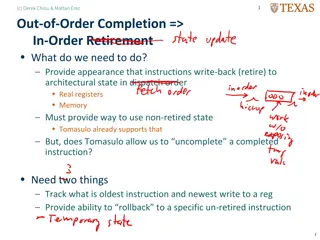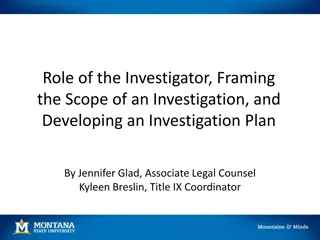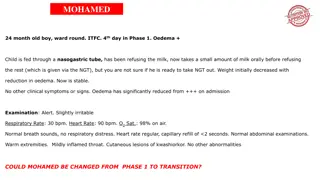Comprehensive Investigation of a 72-Year-Old Retired Market Researcher with NHL
Mrs. GE, a retired market researcher, presents with increasing fatigue, night sweats, abnormal blood film, and splenomegaly. Her medical history includes surgeries and hypertension. Examination reveals reduced air entry in the chest and calf swelling. Further investigations indicate a large B-cell lymphoma infiltration. NHL risk factors and subtypes are discussed.
Download Presentation

Please find below an Image/Link to download the presentation.
The content on the website is provided AS IS for your information and personal use only. It may not be sold, licensed, or shared on other websites without obtaining consent from the author.If you encounter any issues during the download, it is possible that the publisher has removed the file from their server.
You are allowed to download the files provided on this website for personal or commercial use, subject to the condition that they are used lawfully. All files are the property of their respective owners.
The content on the website is provided AS IS for your information and personal use only. It may not be sold, licensed, or shared on other websites without obtaining consent from the author.
E N D
Presentation Transcript
MRS GE 72 years old retired Market Researcher. 3 month history of increasing fatigue associated with one week of drenching night sweats. B/G: URTI with longstanding cough. Referred from GP with abnormal blood film and marked splenomegaly with retroperitoneal LAD on CT (Abdo) Denied weight loss/fevers
PAST MEDICAL HISTORY Tonsillectomy (3yo) Appendectomy (17yo) Unilateral Oophorectomy (17yo) Hysterectomy (38yo) Hypertension Tibolone Atenolol Doxepin
SOCIAL HISTORY Retired Financial Researcher From home with Husband (Marketing) Two adopted daughters (Bentleigh/Malvern) Previously very fit & fiercely independent
ON EXAMINATION X X X X X X X X Orientated Chest: Reduced bibasal air entry. Creps to mid zones. Abdomen: Mild Splenomegally. SNT. Peripherally: Right calf swelling. Not tender to palpation. >
INVESTIGATIONS Hb 84 Neut 2.0 Lymph 1.8 Mono 1.7 H ALP: 118 GGT: 184 ALT: 80 AST: 87 Br: 13 LDH: 567
INVESTIGATIONS BMAT: Markedly hypercellular marrow with extensive infiltration by large B cell lymphoma. Normal bony trabecular architecture. Markedly reduced erythro/granulopoeisis. CD 20 strongly positive on IHC and CD3 minor component of admixed T cells. CT CAP: 16cm Splenomegally, retroperitoneal lymphadenopathy up to 1.5cm in diameter. Shotty inguinal lymph nodes. Nil chest involvement. PET: Awaiting results ECHO: EF 70 percent. Mild MR/TR.
EPIDEMIOLOGY & RISK FACTORS NHL represents the fifth most common malignancy diagnosed in men and the sixth most common in women, with the incidence being approximately 39% higher in men. Most cases of non-Hodgkin lymphoma occur in adults aged 65 years and older. The risk of developing it increases as you get older (it can also occur in children and young adults) Risk Factors Previous infections with viruses such as Epstein-Barr virus, human immunodeficiency virus (HIV), human T-lymphotropic virus type 1 (HTLV-1) and hepatitis C Chemical exposure including pesticides, fertilisers or solvents Autoimmune diseases including rheumatoid arthritis, scleroderma and Sj gren s syndrome Previous organ transplant Infections with certain bacteria including Helicobacter pylori A family history of NHL.
NHL SUBTYPES B-Cell Lymphomas Precursor B-cell lymphomas T -Cell Lymphomas Precursor T-cell lymphomas Precursor B-cell lymphoblastic leukaemia/lymphoma Mature B-cell lymphomas Precursor T-cell lymphoblastic leukaemia/lymphoma Mature T-cell lymphomas Follicular lymphoma Mantle cell lymphoma Diffuse large B-cell lymphoma: Mediastinal large B-cell lymphoma Burkitt s lymphoma B-cell chronic lymphocytic leukaemia/small lymphocytic lymphoma Marginal zone lymphomas: Extranodal marginal zone B-cell lymphoma of mucosa-associated lymphoid tissue (MALT) type Splenic marginal zone B-cell lymphoma Nodal marginal zone lymphoma Lymphoplasmacytic lymphoma (Waldenstrom s macroglobulinaemia) Adult T-cell leukaemia/lymphoma Anaplastic large cell lymphoma Cutaneous T-cell lymphoma (including mycosis fungoides and Sezary syndrome) Peripheral T-cell lymphomas: Subcutaneous panniculitis-like T-cell lymphoma Hepatosplenic gamma-delta T-cell lymphoma Enteropathy-type intestinal T-cell lymphoma Extranodal T-cell lymphoma, nasal type Angioimmunoblastic T-cell lymphoma Peripheral T-cell lymphoma, unspecified
ANN ARBOR STAGING Stage I Single nodal area or structure Stage IITwo or more nodal areas on the same side of the diaphragm Stage III Nodal areas on both sides of the diaphragm Stage IV Extranodal involvement B Symptoms Fever >38 C weight loss >10% in the preceding 6 months drenching night sweats
COIFFIER, ET AL. NEJM. 2002. Population/Methods Untreated patients with diffuse large-B-cell lymphoma 60 to 80 years old CHOP every three weeks (197 patients) versus CHOP plus rituximab given on day 1 of each cycle (202 patients) Results Complete response was significantly higher in the group that received CHOP plus rituximab than in the group that received CHOP alone (76 percent vs. 63 percent, P=0.005). The addition of rituximab to standard CHOP chemotherapy significantly reduced the risk of treatment failure and death (risk ratios, 0.58 [95 percent confidence interval, 0.44 to 0.77] and 0.64 [0.45 to 0.89], respectively). Continued
EVENT-FREE AN OS TIMES WERE SIG. HIGHER IN THE CHOP-R GROUP (P<0.001 AND P=0.007, RESPECTIVELY).
CLINICALLY RELEVANT TOXICITY WAS NOT SIGNIFICANTLY GREATER W CHOP PLUS RITUXIMAB.
A Predictive Model for Aggressive Non-Hodgkin's Lymphoma. New England Journal of Medicine329, 987-994, doi:doi:10.1056/NEJM199309303291402 (1993). Coiffier, B. et al. CHOP Chemotherapy plus Rituximab Compared with CHOP Alone in Elderly Patients with Diffuse Large-B-Cell Lymphoma. New England Journal of Medicine346, 235-242, doi:doi:10.1056/NEJMoa011795 (2002). Coiffier, B. et al.Long-term outcome of patients in the LNH-98.5 trial, the first randomized study comparing rituximab- CHOP to standard CHOP chemotherapy in DLBCL patients: a study by the Groupe d'Etudes des Lymphomes de l'Adulte. Vol. 116 (2010).












